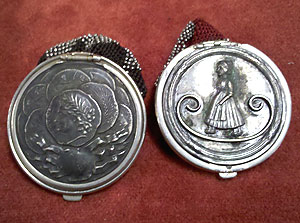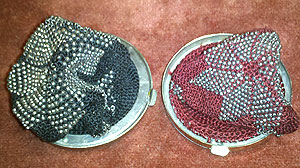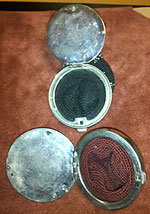I was browsing through the “good-stuff” in the glass cases at an auction house this week when I spotted two small pewter-like items with high reliefs on the tops. I stopped, curious about what they were.

“They’re coin purses,” J.J., an auctioneer, said from behind the counter as she pulled out the tray for me to take a closer look. Standing near us was an antiques store owner, a regular just like me, who was familiar with the pieces. “Victorian,” she added.
I saw that they were very small items; the tops were as wide as the purses were deep. They were no more than 2″ x 3″, and I could envision them being very practical to hold a few coins.
The tops were made of steel, the bottom steel beads worked into mesh fabric. One bottom was burgundy with the top a woman in full form. The other was black with the top the head of a classical figure.
They were both in remarkably good condition, considering the patent dates engraved on them (patent dates do not necessarily mean manufacturing dates, though):
Dec. 15 03 (the year 1903) – burgundy
Mar 25 90 (the year 1890) – black

In my research, I found out that these were called “Tam o ‘ Shanter” purses, apparently named after the Scottish caps first worn by men. The cap got its name from the main character in the poem “Tam o’ Shanter: A Tale,” written by Robert Burns in 1790.
These purses came into use from the late 1800s through the early 1900s, according to the Antiques Off Broadway website. Tam o’ Shanters had a flexible bottom with metal beads knitted into an eight-pointed star. Some tops were silver, but most were “nickel silver over brass with repousse or embossed designs of coins, portraits and Art Nouveau florals. Magazines offered instructions for making these purses at home,” according to the website.
 Purses have not always been what women carried. Early on, men kept them because they were the ones who controlled the family’s money, hanging them on a belt or under their clothes, according to the website. By the 1800s, a new kind of coin purse called the miser (stocking-like with one flat end and one round end) was worn over the belt. Later, the very small sovereign purse was used to carry English gold coins. By the latter part of the century, the Tam o’ Shanter came along.
Purses have not always been what women carried. Early on, men kept them because they were the ones who controlled the family’s money, hanging them on a belt or under their clothes, according to the website. By the 1800s, a new kind of coin purse called the miser (stocking-like with one flat end and one round end) was worn over the belt. Later, the very small sovereign purse was used to carry English gold coins. By the latter part of the century, the Tam o’ Shanter came along.
When I think of early coin purses, I have this image in my head – likely from some old movie made from a Charles Dickens’ novel – of a stooped man heavy coat about his shoulders dropping a coin from his clutch change purse into the hands of a child or poor person on the streets.
But that wasn’t the look of the anrtique purses at the auction. These were lovely.
I wasn’t around when they were sold, but I found plenty for purchase on the web – from sterling silver to Mother of Pearl to tortoise shell. This one with angels on the cover and a leather bottom was selling for $115; sterling silver carry-all, $139; sterling silver British purse, $324; compact and coin purse, $350.
 I also found one advertised to be worn as a pendant ($149), but was made to be hung from a chatelaine the way Victorian women would do. A fancy hook, chatelaines held several chains on which could be hung watches, needle cases, pencils and more.
I also found one advertised to be worn as a pendant ($149), but was made to be hung from a chatelaine the way Victorian women would do. A fancy hook, chatelaines held several chains on which could be hung watches, needle cases, pencils and more.
At the auction, the antique shop owner mentioned that coin purses sold very well about 10 years ago, but today people just like touching them. I understood that response: They are so delicate that you do want to trace the high relief on the top with one finger and rub across the tiny beads with all your fingers.
Unfortunately, I couldn’t carry one of these purses. It could never hold all the quarters and pennies I lug around.
